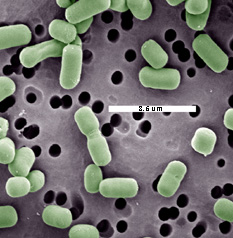Lactobacillus brevis is an heterofermentative bacterium that utilizes hexoses by the 6-phosphogluconate pathway, producing lactic acid, CO2 and ethanol and/or acetic acid in equimolar amounts (Kandler, 1983). It can be isolated from many different environments and it is frequently used as starter culture in silage fermentation, sourdough and lactic-acid-fermented types of beer. In beverages obtained by alcoholic fermentation, lactobacilli may contribute to the quality of the product but may also cause spoilage. Certain L. brevis strains are resistant to hop bittering substances such as isohumulone and are able to grow in beer. Their growth changes the turbidity, flavor and aroma of the beer (Richards and Macrae, 1964). L. brevis strains involved in wine fermentation may produce biogenic amines by decarboxylation of the precursor amino acids through the action of substrate-specific enzymes. The ingestion of foods containing high levels of such amines, particularly histamine and tyramine, can lead to several toxicological disturbances (ten Brink et al., 1990; Mariné-Font et al., 1995). References Kandler, O. 1983. Carbohydrate metabolism in lactic acid bacteria Ant. v. Leeuwenhoek, vol. 49, pp. 209–224. Kandler, O.; N. Weiss. 1986. Regular, non-sporing Gram-positive rods, p. 1208–1234. In: P. H. A. Sneath, N. Mair, M. E. Sharpe, and J. G. Holt (ed.), Bergey's manual of systematic bacteriology, vol. 2. William and Wilkins, Baltimore. Mariné-Font, A., M. C. Vidal-Carou, M. Izquierdo-Pulido, M. T Venciana-Nogués, and T. Hernández-Jover. 1995. Les amines biogénes dans les aliments: leur signification, leur analyse. Ann. Fals. Exp. Chim, vol 88, pp. 11-140. Richards, M.; R. M. Macrae. 1964. The significance of the use of hops in regard to the biological stability of beer. II. The development of resistance to hop resins by strains of lactobacilli.J. Inst. Brewing, vol. 70, pp. 484–488. Ten Brink, B., C. Damink, H. M. L. J. Joosten, and J. H. J. Huis in´t Veld. 1990. Occurrence and formation of biologically active amines in foods. Int. J. Food Microbiol, vol 11, pp. 73-84. |
||
|
||
Lactobacillus brevis ATCC 367

